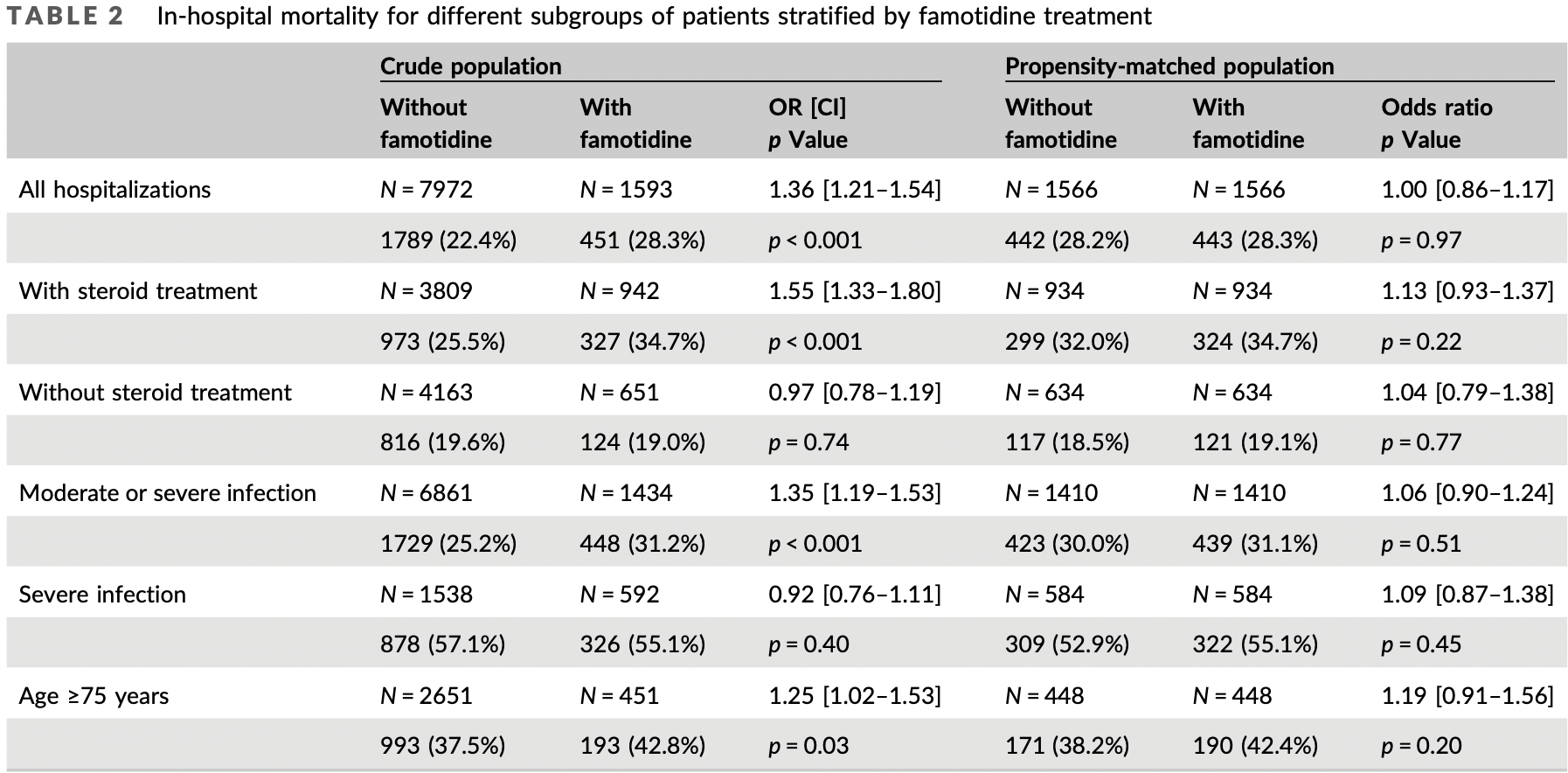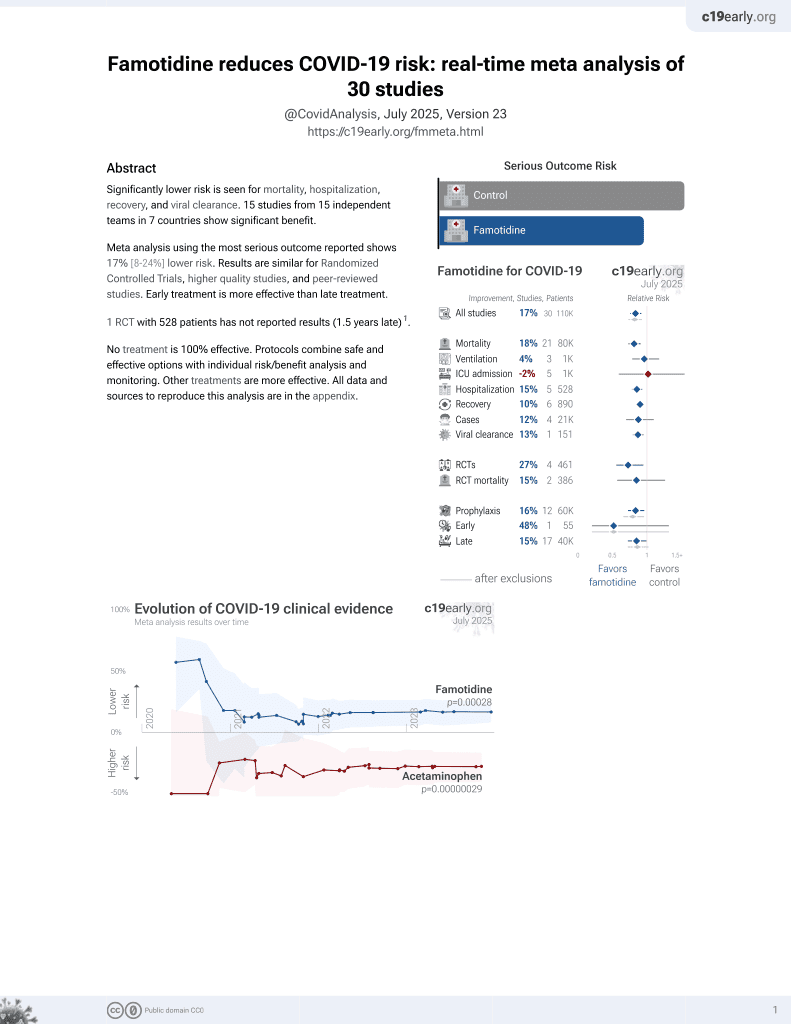
The association between famotidine and in-hospital mortality of patients with COVID-19
et al., Journal of Medical Virology, doi:10.1002/jmv.27375, Oct 2021
Famotidine for COVID-19
29th treatment shown to reduce risk in
October 2021, now with p = 0.00028 from 30 studies, recognized in 2 countries.
No treatment is 100% effective. Protocols
combine treatments.
6,300+ studies for
210+ treatments. c19early.org
|
PSM retrospective 9,565 COVID-19 hospitalized patients in the USA, 1,593 receiving famotidine, showing no significant difference in mortality.
Standard of Care (SOC) for COVID-19 in the study country,
the USA, is very poor with very low average efficacy for approved treatments1.
Only expensive, high-profit treatments were approved for early treatment. Low-cost treatments were excluded, reducing the probability of early treatment due to access and cost barriers, and eliminating complementary and synergistic benefits seen with many low-cost treatments.
|
risk of death, no change, OR 1.00, p = 0.97, treatment 1,593, control 7,972, RR approximated with OR.
|
| Effect extraction follows pre-specified rules prioritizing more serious outcomes. Submit updates |
Kuno et al., 11 Oct 2021, retrospective, propensity score matching, USA, peer-reviewed, 4 authors, study period 1 March, 2020 - 30 March, 2021.
The association between famotidine and in‐hospital mortality of patients with COVID‐19
Journal of Medical Virology, doi:10.1002/jmv.27375
Famotidine has been considered to be a potential treatment for COVID-19 but the current data is conflicting. This retrospective study was conducted by utilizing data of 9565 COVID-19 hospitalized patients. Patients treated with and without famotidine were matched by propensity score using a 1:1 matching scheme. A total of 1593 patients (16.7%) received famotidine. In-hospital mortality was similar in patients treated with and without famotidine in the propensity-matched cohorts (28.3% vs. 28.2%, p = 0.97), which remains similar irrespective of severity or concomitant treatment by steroids. Famotidine treatment was not associated with a lower risk of in-hospital mortality of COVID-19 patients.
CONFLICT OF INTERESTS The authors declare that there are no conflict of interests.
ETHICS STATEMENT This study was approved by the Institutional Review Boards (#2000495) and conducted in accordance with the principles of the Declaration of Helsinki. The waiver of patients' informed consent was also approved by the institutional review boards.
AUTHOR CONTRIBUTIONS Toshiki Kuno, Mai Takahashi, and Natalia N. Egorova had full access to all the data in the study and takes responsibility for the integrity of the data and the accuracy of the data analysis. Study concept and design: Toshiki
References
Castells, Butterfield, Mast cell activation syndrome and mastocytosis: initial treatment options and long-term management, J Allergy Clin Immunol Pract
Freedberg, Conigliaro, Wang, Famotidine use is associated with improved clinical outcomes in hospitalized COVID-19 patients: a propensity score matched retrospective cohort study, Gastroenterology
Kuno, Miyamoto, Iwagami, Ishimaru, Takahashi et al., The association of remdesivir and in-hospital outcomes for COVID-19 patients treated with steroids, J Antimicrob Chemother
Kuno, So, Miyamoto, Iwagami, Takahashi et al., The association of COVID-19 antibody with in-hospital outcomes in COVID-19 infected patients, J Med Virol, doi:10.1002/jmv.27260
Kuno, So, Takahashi, Egorova, U shape association of hemoglobin level with in-hospital mortality for COVID-19 patients, J Thromb Thrombolysis
Malone, Tisdall, Smith, COVID-19: famotidine, histamine, mast cells, and mechanisms, Front Pharmacol
Mather, Seip, Mckay, Impact of famotidine use on clinical outcomes of hospitalized patients with COVID-19, Am J Gastroenterol
Mukherjee, Bhattacharya, Bojkova, Famotidine inhibits toll-like receptor 3-mediated inflammatory signaling in SARS-CoV-2 infection, J Biol Chem
Shoaibi, Fortin, Weinstein, Berlin, Ryan, Comparative effectiveness of famotidine in hospitalized COVID-19 patients, Am J Gastroenterol
So, Kabata, Takahashi, Egorova, Kuno, The association of inhaled corticosteroid before admission and survival of patients with COVID-19, J Aerosol Med Pulm Drug Deliv
Sterne, Murthy, Diaz, Association between administration of systemic corticosteroids and mortality among critically ill patients with COVID-19: a meta-analysis, JAMA
DOI record:
{
"DOI": "10.1002/jmv.27375",
"ISSN": [
"0146-6615",
"1096-9071"
],
"URL": "http://dx.doi.org/10.1002/jmv.27375",
"alternative-id": [
"10.1002/jmv.27375"
],
"archive": [
"Portico"
],
"assertion": [
{
"group": {
"label": "Publication History",
"name": "publication_history"
},
"label": "Received",
"name": "received",
"order": 0,
"value": "2021-08-16"
},
{
"group": {
"label": "Publication History",
"name": "publication_history"
},
"label": "Accepted",
"name": "accepted",
"order": 1,
"value": "2021-10-01"
},
{
"group": {
"label": "Publication History",
"name": "publication_history"
},
"label": "Published",
"name": "published",
"order": 2,
"value": "2021-10-11"
}
],
"author": [
{
"ORCID": "http://orcid.org/0000-0002-2487-8366",
"affiliation": [
{
"name": "Division of Cardiology, Montefiore Medical Center Albert Einstein College of Medicine New York New York USA"
},
{
"name": "Department of Medicine, Icahn School of Medicine at Mount Sinai Mount Sinai Beth Israel New York New York USA"
}
],
"authenticated-orcid": false,
"family": "Kuno",
"given": "Toshiki",
"sequence": "first"
},
{
"affiliation": [
{
"name": "Department of Medicine, Icahn School of Medicine at Mount Sinai Mount Sinai Beth Israel New York New York USA"
}
],
"family": "So",
"given": "Matsuo",
"sequence": "additional"
},
{
"affiliation": [
{
"name": "Department of Medicine, Icahn School of Medicine at Mount Sinai Mount Sinai Beth Israel New York New York USA"
}
],
"family": "Takahashi",
"given": "Mai",
"sequence": "additional"
},
{
"affiliation": [
{
"name": "Department of Population Health Science and Policy Icahn School of Medicine at Mount Sinai New York New York USA"
}
],
"family": "Egorova",
"given": "Natalia N.",
"sequence": "additional"
}
],
"container-title": [
"Journal of Medical Virology"
],
"content-domain": {
"crossmark-restriction": true,
"domain": [
"onlinelibrary.wiley.com"
]
},
"created": {
"date-parts": [
[
2021,
10,
7
]
],
"date-time": "2021-10-07T04:21:17Z",
"timestamp": 1633580477000
},
"deposited": {
"date-parts": [
[
2022,
1,
19
]
],
"date-time": "2022-01-19T16:21:34Z",
"timestamp": 1642609294000
},
"indexed": {
"date-parts": [
[
2022,
1,
20
]
],
"date-time": "2022-01-20T06:41:20Z",
"timestamp": 1642660880036
},
"is-referenced-by-count": 0,
"issn-type": [
{
"type": "print",
"value": "0146-6615"
},
{
"type": "electronic",
"value": "1096-9071"
}
],
"issue": "3",
"issued": {
"date-parts": [
[
2021,
10,
11
]
]
},
"journal-issue": {
"issue": "3",
"published-print": {
"date-parts": [
[
2022,
3
]
]
}
},
"language": "en",
"license": [
{
"URL": "http://onlinelibrary.wiley.com/termsAndConditions#vor",
"content-version": "vor",
"delay-in-days": 0,
"start": {
"date-parts": [
[
2021,
10,
11
]
],
"date-time": "2021-10-11T00:00:00Z",
"timestamp": 1633910400000
}
},
{
"URL": "http://doi.wiley.com/10.1002/tdm_license_1.1",
"content-version": "tdm",
"delay-in-days": 0,
"start": {
"date-parts": [
[
2021,
10,
11
]
],
"date-time": "2021-10-11T00:00:00Z",
"timestamp": 1633910400000
}
}
],
"link": [
{
"URL": "https://onlinelibrary.wiley.com/doi/pdf/10.1002/jmv.27375",
"content-type": "application/pdf",
"content-version": "vor",
"intended-application": "text-mining"
},
{
"URL": "https://onlinelibrary.wiley.com/doi/full-xml/10.1002/jmv.27375",
"content-type": "application/xml",
"content-version": "vor",
"intended-application": "text-mining"
},
{
"URL": "https://onlinelibrary.wiley.com/doi/pdf/10.1002/jmv.27375",
"content-type": "unspecified",
"content-version": "vor",
"intended-application": "similarity-checking"
}
],
"member": "311",
"original-title": [],
"page": "1186-1189",
"prefix": "10.1002",
"published": {
"date-parts": [
[
2021,
10,
11
]
]
},
"published-online": {
"date-parts": [
[
2021,
10,
11
]
]
},
"published-print": {
"date-parts": [
[
2022,
3
]
]
},
"publisher": "Wiley",
"reference": [
{
"DOI": "10.3389/fphar.2021.633680",
"doi-asserted-by": "publisher",
"key": "e_1_2_6_2_1"
},
{
"DOI": "10.14309/ajg.0000000000000832",
"doi-asserted-by": "publisher",
"key": "e_1_2_6_3_1"
},
{
"DOI": "10.1053/j.gastro.2020.05.053",
"doi-asserted-by": "publisher",
"key": "e_1_2_6_4_1"
},
{
"DOI": "10.14309/ajg.0000000000001153",
"doi-asserted-by": "publisher",
"key": "e_1_2_6_5_1"
},
{
"DOI": "10.1001/jama.2020.17023",
"doi-asserted-by": "publisher",
"key": "e_1_2_6_6_1"
},
{
"DOI": "10.1016/j.jaip.2019.02.002",
"doi-asserted-by": "publisher",
"key": "e_1_2_6_7_1"
},
{
"article-title": "The association of COVID‐19 antibody with in‐hospital outcomes in COVID‐19 infected patients",
"author": "Kuno T",
"journal-title": "J Med Virol",
"key": "e_1_2_6_8_1",
"year": "2021"
},
{
"DOI": "10.1093/jac/dkab256",
"doi-asserted-by": "publisher",
"key": "e_1_2_6_9_1"
},
{
"article-title": "U shape association of hemoglobin level with in‐hospital mortality for COVID‐19 patients",
"author": "Kuno T",
"first-page": "1",
"journal-title": "J Thromb Thrombolysis",
"key": "e_1_2_6_10_1",
"volume": "2",
"year": "2021"
},
{
"DOI": "10.1089/jamp.2021.0020",
"doi-asserted-by": "publisher",
"key": "e_1_2_6_11_1"
},
{
"DOI": "10.1016/j.jbc.2021.100925",
"doi-asserted-by": "publisher",
"key": "e_1_2_6_12_1"
}
],
"reference-count": 11,
"references-count": 11,
"relation": {},
"score": 1,
"short-container-title": [
"Journal of Medical Virology"
],
"short-title": [],
"source": "Crossref",
"subject": [
"Infectious Diseases",
"Virology"
],
"subtitle": [],
"title": [
"The association between famotidine and in‐hospital mortality of patients with COVID‐19"
],
"type": "journal-article",
"update-policy": "http://dx.doi.org/10.1002/crossmark_policy",
"volume": "94"
}
